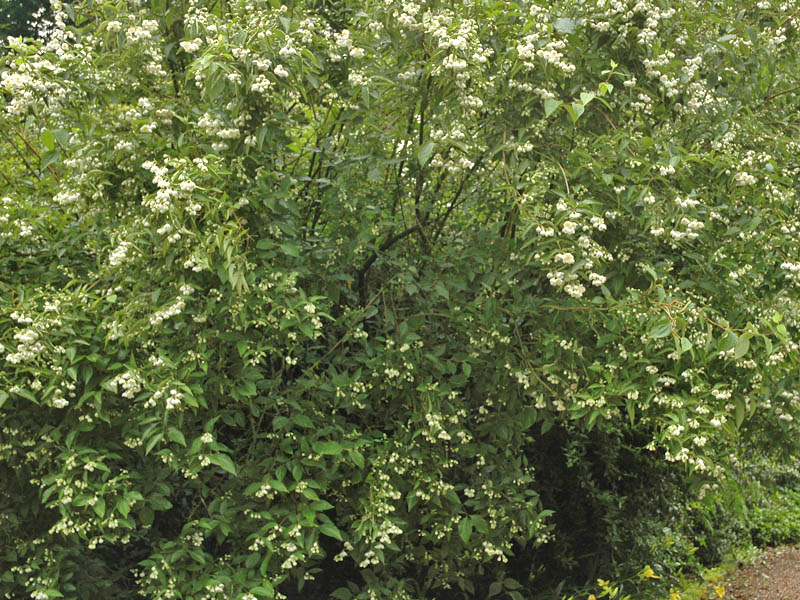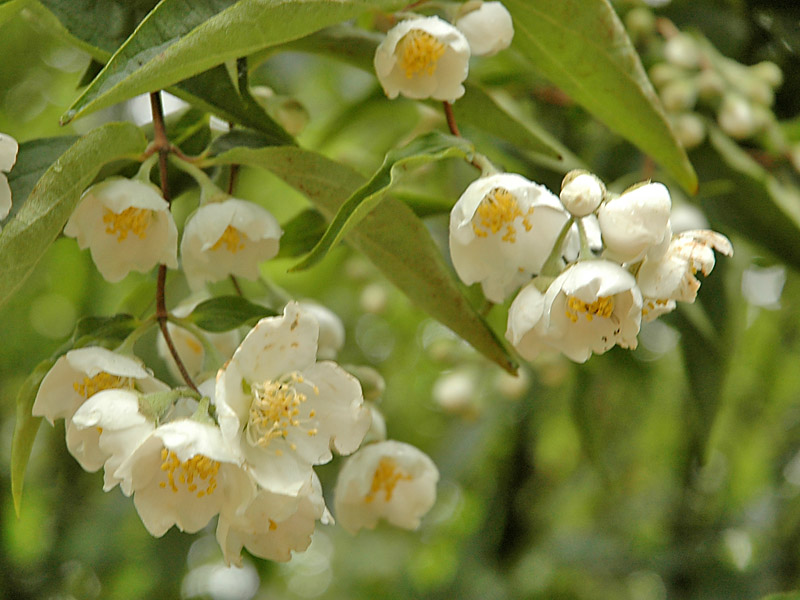
Woody > Philadelphus > Philadelphus incanus > Philadelphus incanus
Philadelphus incanus
Mock Orange
Origin: Native of western Hubei, Shaanxi and western Honan provinces, China.
Mike's
Opinion


"
Now a somewhat dated shrub because of its large size, Philadelphus incanus is known for its sweet fragrance and creamy white flowers. Its genus name is derived from the Greek for ‘brotherly love,’ and its blossoms bear great resemblance to that of the orange tree, resulting in the common name ‘Mock Orange', but sometimes called Syringa. A relatively unremarkable shrub when not in bloom, it proves most aesthetically appealing in flower and when combined with other shrubs in the garden border. P. incanus is a resilient and easy to cultivate plant, and grows best when pruned regularly.
Michael Pascoe, NDP., ODH., CLT., MSc. (Plant Conservation)
"
| Family |
| Hydrangeaceae |
| Genus |
| Philadelphus |
| Species |
| incanus |
| Category |
| Woody |
| Type |
| Shrub (deciduous) |
| Pronunciation |
| USDA Hardiness Zone |
| 4a - 8a |
| Canadian Hardiness Zone |
| 2a - 4a |
| Temperature (°C) |
| -20 |
| Temperature (°F) |
| -4 |
| Height |
| 1.5 - 4 m |
| Spread |
| 1.5 - 4 m |
Photographs
Description and Growing Information
Flowering Period
| General Description |
| A large shrub with fountain-like branch habit. A vigorous plant requiring dedicated pruning to maintain a 'tidy' form. Single white flowers produce a lightly sweet aroma are held against dark green, unassuming foliage. |
| Landscape |
| Primarily planted for its scented flowers it may also be used as a specimen plant, border or a background shrub for screening. It should be planted with other more 'centre stage' shrubs for optimum effect. |
| Cultivation |
| Prefers neutral to slightly acidic soils (pH 6.0-7.0) and can tolerate both pollution and drought. Requires pruning maintenance after flowering since it can become unkempt (lightly prune away older growth). It transplants easily but is sensitive to fertilizer burn. |
| Shape |
| Upright and rounded, with a fountain-like branching habit. |
| Growth |
| Fast |
| ID Characteristic |
| Creamy white single flowers with a slight, sweet fragrance. Blooms later in the summer (late June/July), distinguishing it from other Philadelphus species which typically bloom earlier. Dense, appressed hairs on ovate, dark green leaves; lacking interesting autumn colour. |
| Pests |
| Leaf spot, powdery mildew and aphids have been noted but are seldom of concern. |
| Habitat |
| Found in thickets, in scrub and by streams at elevations of 1200-1700 m. Prefers well-drained, moist soils and grows in full sun to partial shade. |
| Bark/Stem Description |
| Thin, exfoliating bark; brown in colour. Older bark will appear grey-brown, whereas new growth will appear a darker brown to purple. |
| Flower/Leaf Bud Description |
| Singular with two valvate scales. |
| Leaf Description |
| The simple leaf is ovate or broadly ovate; dark green, opposite in arrangement and ranges in length from 5-8 cm. |
| Flower Description |
| The 4.5 cm blooms, on the previous years growth are single, four petalled, white with prominent, multiple yellow stamens. The blooms emit a mild, sweet scent. in mid to late summer (late June/July). |
| Fruit Description |
| Produces a light brown dehiscent pod with tiny dark brown seeds which splits open late in the season. The pod is obovoid, 7-9 mm long and 4-7 mm wide while seeds are between 1.5- 2.5 mm in size with miniscule protruding tails. |
| Colour Description |
| Flowers are a rich white to off-white with golden stamens. The foliage is dark green that fades to medium-light green in the autumn prior to leaf drop. Bark; is brown in colour while on mature plants it will appear grey-brown, while new growth is dark brown to purple. |
| Texture Description |
| A fine to medium textured plant if maintained through annual pruning. |
| Notable Specimens |
| The North American Woodland Bed at the Royal Botanic Gardens, Melbourne, Australia. |
| Propagation |
| Propagated from softwood, hardwood cuttings and semi-ripe wood or seed. Hardwood cuttings can be taken any time during the dormant season (easiest in late autumn or early spring); softwood cuttings in midsummer, when new growth begins to harden; semi-ripe wood taken mid to late summer. All type of cuttings root easily under bottom heat, rooting hormone and light mist in perlite. Seed although effective is slow and is seldom used today. |
References
Phillips, Roger and Martyn Rix. “Shrubs.” New York: Random House, 1989.
Lonnee, Debbie and Nancy Rose, Don Selinger and John Whitman. “Growing Shrubs and Small Trees in Cold Climates.” Minneapolis: University of Minnesota Press, 2011.

